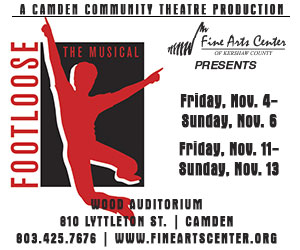Natalie Brown – Keeping the Circus Going
By Cynthia Boiter
Keep the circus going inside you, keep it going, don’t take anything too seriously, it’ll all work out in the end. — David Niven
Many years ago, and certainly before Columbia performing artist Natalie Brown was born, there was a game show which ran on the CBS network from 1950 until 1967 called What’s My Line? The point of the program was for four regularly appearing celebrity panelists to try to guess the occupation of a contestant by asking him or her questions which could only be answered with yes or no. The catch was that, more often than not, the contestant either enjoyed an unusual profession, or she or he looked nothing like what one would expect a person in said occupation to look.
If Natalie Brown had been a contestant on What’s My Line, she would have broken the bank.
To see Brown in her street clothes, with typical low-key make up and jewelry, one would never expect that the brown haired and mild mannered young woman could take to the stage like a peacock gone a ‘courting – hips swaying, abdomen thrusting, spine all akimbo. But once having witnessed the sequined spectacle of a beaded and bedazzled, feather-encrusted Brown, it’s easy to admit that the lady was born to dance – belly dance, that is.
The child of a career military father, Brown bounced about different locations during her childhood, eventually settling in Irmo for her last two years of school at Irmo High. A bit a of self-proclaimed “odd duck,” she gleefully left the midlands behind after graduation for a full ride to New Orleans’ Tulane University and a year studying abroad in London. It was in the pep band at Tulane that Brown, a flutist, met her future love, photographer and French horn player, Toby Morriss. “We hit it off almost immediately,” she says, and the two eventually moved in together.
Brown, who was freelancing as a writer for the New Orleans alternative newspaper, The Gambit Weekly, had thrown her back out at the age of 22 during her last year of college, and continued to suffer with back pain two years later. “I still had pain and felt stiff,” she says, “and I was looking for something to do to rehabilitate my back and put my body back together.” When word came her way about a belly dance class, she thought why not? “I was hooked from the very beginning,” she admits.
“I progressed quickly and almost immediately fixed my posture,” she says. What’s more, the artistically-minded young woman soon realized that belly dancing held the answer to more than just one question in her life. “I had been struggling after college trying to figure out how to make a living, and when I slipped into that belly dance class it was like a big a giant universal puzzle piece just fell into place. I knew I wanted to do this for a long, long time.”
After six months, the student had worked up to taking classes three times per week and was performing in a student belly dance company in New Orleans. But within another half year, tragedy struck the city in the form of Hurricane Katrina and Brown was forced to evacuate New Orleans with Morriss. They came to Columbia in August 2005 and started over in a home to which Brown had never planned to return.
In late 2005, events turned in her favor when she ventured out one evening to attend a drum circle conducted by an eastern fusion band called Turku. “I dressed in all my tribal gear and went out to dance,” she remembers. “I danced with a lot of girls who wanted to learn tribal dance, so right then, I decided to be a teacher and start my own belly dance company. Besides, I needed to dance to work through my grief over Katrina.”
Brown explains that belly dance, as an art form, varies depending upon whether the style one dances is tribal, her specialty, or cabaret, a more middle eastern style originating in northern Africa but somewhat watered down, if not corrupted, by Hollywood. “Cabaret belly dancing is what you’re more likely to see somewhere like Zorba’s,” Brown says. “It is very feminine and the dancers wear long hair and heavily sequined costumes. The music is orchestral and the style is very flirty and welcoming. It’s usually performed as a solo. The technique is the same as tribal belly dancing, but the stylization is very different.”
While belly dancing as folk art has been practiced for thousands of years, originating on the Arabian peninsula as a dance of women for other women often to assist in childbirth, America’s take on belly dancing began with the 1883 Chicago World’s Fair. It was in the exhibit, A Street in Cairo, where world’s fair talent director Sol Bloom first appropriated belly dancing as a vehicle for his newly found talent Ashea Wabe, also known as Fatima or Little Egypt, shocking contemporary Victorian society with her scanty costuming and undulations.
American Tribal Style Belly Dance, on the other hand, is a much more recent art form, created on the west coast in the mid-twentieth century by Jamila Salimpour, who fused her early work with Ringling Brothers Circus with other forms of folkloric dance. The grand dame of belly dance in the U.S., Salimpour was the first person to codify the American belly dance technique. Her daughter, Suhaila Salimpour, who took up the torch from her mother in the 1980s, has been a major influence on Brown as an instructor and mentor. “She is a very strict teacher,” Brown says, her brown eyes displaying a sense of both reverence and fear.
“Tribal dance tends to be done in a group,” Brown continues to explain. “It requires a strong, empowered posture with earthy movements and strong elbows. In the last twenty years, tribal dancers have started mixing in hip hop, pop and lock, and even some burlesque to create more of a tribal fusion which is, in many ways, divorced from the Middle Eastern roots.”
It is this type of fusion or mixing of art forms that Brown has cultivated in her teaching and the design of her dance troupe which, in April 2006, began practicing under the name Delirium Tribal. By September 2007, after a series of collaborations with the fire performance art of Steve Oswanski, Brown added additional performers to the troupe, creating a variety show format, and changed the name to Columbia Alternacirque. Themed shows followed with written scripts and the addition of best friend and local poet Kendal Turner, who now serves as ringmaster and circus narrator, with regularly scheduled performances staged predominantly at the Art Bar on Park Street in Columbia’s Vista.
“I’m always learning,” Brown admits. “I’ve learned to rely on the advice of smart people,” crediting local arts leaders like Katie Fox and Lauren Michalski with providing support and counsel as she has navigated the waters of developing an operational budget, securing insurance for her performances, and bringing the troupe up to the standards of a professional operation. An April 2011 performance at the River Walk Amphitheater in West Columbia “finally turned a profit,” she says with relief.
With a smaller company now, Brown continues to teach in the studios of the Columbia Music Festival Association, which is also where the troupe rehearses. “We would not exist without CMFA – they’ve been phenomenal to us,” Brown confesses. After splitting in 2006 with Morriss, who was later tragically killed by a hit-and-run driver in 2010, Brown now lives with her mother In Irmo, teaches an introduction to Belly Dance class for the P. E. department at USC and, in her words, “obsesses” about her dance troupe which she casually refers to as “the circus.”
It was Brown’s obsessive diligence which led her, late in 2011, to successfully complete a Kickstarter fundraising campaign that will allow the circus to purchase equipment and set supplies, as well as fuel and insurance for future fire performances. And in January 2012, the always planning artist is hosting a multi-day festival in Columbia featuring dance and circus performances, as well as guest artists who specialize in a variety of circus sideshow and Vaudeville acts like hammering railroad spikes up the nose, wearing mousetraps on the tongue, and walking on glass. “I get to show my beloved Columbia all my insecure friends,” she says, without a hint of irony.
To see Brown on the street or having coffee at a local café, modestly dressed in fashionable clothes and thoroughly unassuming, one would never guess that she keeps the company of fire eaters and other self-proclaimed freaks, or that she wiles away her hours deep into the night meticulously hot gluing beads and bangles on costumes she’ll soon wear on stage to shimmy and shake. But to hear her talk about it – about the circus and the performers and all the plans she has for them, there’s no doubt that the circus will keep going inside of Natalie Brown. And it will all work out in the end.






.jpg)
